A Compact C-Band Bandpass Filter with an Adjustable Dual-Band Suitable for Satellite Communication Systems
Abstract
:1. Introduction
2. Design Procedure
2.1. Proposed Coupling System
2.2. Proposed Dual-Band BPF
2.3. Current Distribution Analysis
2.4. Passbands Optimization and Tuning of the Filter
3. Results and Discussions
4. Conclusions
Author Contributions
Funding
Conflicts of Interest
References
- Karimi, G.; Pourasad, Y.; Lalbakhsh, A.; Siahkamari, H.; Mohamadzade, B. Deign of a compact ultra-narrow band dual band filter for WiMAX application. AEU Int. J. Electron. Commun. 2019, 110, 152827. [Google Scholar] [CrossRef]
- Roshani, S.; Roshani, S.; Zarinitabar, A. A modified Wilkinson power divider with ultra harmonic suppression using open stubs and lowpass filters. Analog Integr. Circ. Signal Process. 2019, 98, 395–399. [Google Scholar] [CrossRef]
- Ghaderi, A.; Golestanifar, A.; Shama, F. Microstrip bandpass filters using coupled feed lines for third and fourth generation communications. AEU Int. J. Electron. Commun. 2018, 86, 195–201. [Google Scholar] [CrossRef]
- Amirian, M.; Karimi, G.; Lalbakhsh, A.; Bayati, M.S. Compact differential bandpass filter with a narrow notched band using APCL structure suitable for UWB application. Microelectron. J. 2015, 46, 869–874. [Google Scholar] [CrossRef]
- Rostami, P.; Roshani, S. A miniaturized dual band Wilkinson power divider using capacitor loaded transmission lines. AEU Int. J. Electron. Commun. 2018, 90, 63–68. [Google Scholar] [CrossRef]
- Karimi, G.; Lalbakhsh, A.; Dehghani, K.; Siahkamari, H. Analysis of novel approach to design of ultra-wide stopband microstrip low-pass filter using modified U-shaped resonator. ETRI J. 2015, 37, 945–950. [Google Scholar] [CrossRef]
- Malakooti, S.A.; Mousavi, S.M.; Fumeaux, C. Tunable bandpass-to-bandstop quasi-Yagi–Uda antenna with sum and difference radiation patterns. IEEE Transact. Antennas Propag. 2019, 67, 2260–2271. [Google Scholar] [CrossRef]
- Karimi, G.; Amirian, M.; Lalbakhsh, A.; Ranjbar, M. A new microstrip coupling system for realization of a differential dual-band bandpass filter. AEU Int. J. Electron. Commun. 2019, 99, 186–192. [Google Scholar] [CrossRef]
- Jamshidi, M.; Siahkamari, H.; Roshani, S.; Roshani, S. A compact Gysel power divider design using U-shaped and T-shaped resonators with harmonics suppression. Electromagnetics 2019, 39, 1–4. [Google Scholar] [CrossRef]
- Lalbakhsh, A.; Karimi, G.; Sabaghi, F. Triple mode spiral wideband bandpass filter using symmetric dual-line coupling. Electron. Lett. 2017, 53, 795–797. [Google Scholar] [CrossRef]
- Ghaderi, A.; Golestanifar, A.; Shama, F. Design of a compact microstrip tunable dual-band bandpass filter. AEU Int. J. Electron. Commun. 2017, 82, 391–396. [Google Scholar] [CrossRef]
- Doumanis, E.; Goussetis, G.; Kosmopoulos, S. Filter Design for Satellite Communications: Helical Resonator Technology; Artech House: Norwood, MA, USA, 2015. [Google Scholar]
- Hunter, I.C.; Billonet, L.; Jarry, B.; Guillon, P. Microwave filters-applications and technology. IEEE Transact. Microw. Theory Tech. 2002, 50, 794–805. [Google Scholar] [CrossRef]
- Shaman, H.N. Design of a compact C-band microstrip bandpass filter for satellite communications applications. In Proceedings of the Ninth International Conference on Wireless and Optical Communications Networks (WOCN), Indore, India, 20–22 September 2012; pp. 1–4. [Google Scholar]
- Lagunas, E.; Tsinos, C.G.; Sharma, S.K.; Chatzinotas, S. 5G cellular and fixed satellite service spectrum coexistence in C-band. IEEE Access 2020, 8, 72078–72094. [Google Scholar] [CrossRef]
- Afzal, M.U.; Lalbakhsh, A.; Esselle, K.P. A low-profile beam-tilted antenna array for receiving direct-broadcast satellite services. In Proceedings of the IEEE Asia-Pacific Conference on Antennas and Propagation (APCAP), Auckland, New Zealand, 5–8 August 2018; pp. 147–148. [Google Scholar]
- Lalbakhsh, A.; Afzal, M.U.; Esselle, K.P.; Smith, S.L. Low-cost non-uniform metallic lattice for rectifying aperture near-field of electromagnetic bandgap resonator antennas. IEEE Trans. Antennas Propag. 2020, 68, 3328–3335. [Google Scholar] [CrossRef]
- Eng, J.E.; Frank, S.Y. Low Cost Millimeter Wave Receiver and Method for Operating Same. U.S. Patent 10,263,648, 16 April 2019. [Google Scholar]
- Afzal, M.U.; Lalbakhsh, A.; Esselle, K.P. Electromagnetic-wave beam-scanning antenna using near-field rotatable graded-dielectric plates. J. Appl. Phys. 2018, 124, 912–915. [Google Scholar] [CrossRef]
- Gómez-García, R.; Muñoz-Ferreras, J.M.; Feng, W.; Psychogiou, D. Balanced symmetrical quasi-reflectionless single-and dual-band bandpass planar filters. IEEE Microw. Wirel. Compon. Lett. 2018, 3, 1–3. [Google Scholar] [CrossRef]
- Sans, M.; Selga, J.; Vélez, P.; Bonache, J.; Rodríguez, A.; Boria, V.E.; Martín, F. Compact wideband balanced bandpass filters with very broad common-mode and differential-mode stopbands. IEEE Trans. Microw. Theory Tech. 2018, 66, 737–750. [Google Scholar] [CrossRef]
- Song, Y.; Liu, H.; Zhao, W.; Wen, P.; Wang, Z. Compact balanced dual-band bandpass filter with high common-mode suppression using planar via-free CRLH resonator. IEEE Microw. Wirel. Compon. Lett. 2018, 28, 996–998. [Google Scholar] [CrossRef]
- Fernández-Prieto, A.; Martel, J.; Ugarte-Parrado, P.J.; Lujambio, A.; Martinez-Ros, A.J.; Martín, F.; Medina, F.; Boix, R.R. Compact balanced dual-band bandpass filter with magnetically coupled embedded resonators. IET Microw. Antennas Propag. 2019, 13, 492–497. [Google Scholar] [CrossRef]
- Gu, H.; Ge, L.; Xu, L. Simple dual-mode balanced bandpass filter with high selectivity and extended common-mode noise suppression. Electron. Lett. 2018, 54, 833–835. [Google Scholar] [CrossRef]
- Yang, L.; Zhu, L.; Zhang, R.; Wang, J.; Choi, W.W.; Tam, K.W.; Gómez-García, R. Novel multilayered ultra-broadband bandpass filters on high-impedance slotline resonators. IEEE Trans. Microw. Theory Tech. 2018, 67, 129–139. [Google Scholar] [CrossRef]
- Qiao, H.; Guo, D.; Mou, J.; Li, M.; Ma, Z.; Lv, X. HIS-based bandpass filter with improved upper-stopband performance. Electron. Lett. 2018, 54, 363–364. [Google Scholar] [CrossRef]
- Xu, H.; Wang, J.; Zhu, L.; Huang, F.; Wu, W. Design of a dual-mode balun bandpass filter with high selectivity. IEEE Microw. Wirel. Compon. Lett. 2017, 28, 22–24. [Google Scholar] [CrossRef]
- Li, P.; Chu, H.; Zhao, D.; Chen, R.S. Compact dual-band balanced SIW bandpass filter with improved common-mode suppression. IEEE Microw. Wirel. Compon. Lett. 2017, 27, 347–349. [Google Scholar] [CrossRef]
- Wang, S.; Zhang, D.; Zhang, Y.; Qing, L.; Zhou, D. Novel dual-mode bandpass filters based on SIW resonators under different boundaries. IEEE Microw. Wirel. Compon. Lett. 2016, 27, 28–30. [Google Scholar] [CrossRef]
- Lotfi-Neyestanak, A.A.; Lalbakhsh, A. Improved microstrip hairpin-line bandpass filters for spurious response suppression. Electron lett. 2012, 48, 858–859. [Google Scholar] [CrossRef]
- Lalbakhsh, A.; Neyestanak, A.A.; Naser-Moghaddasi, M. Microstrip hairpin bandpass filter using modified Minkowski fractal-shape for suppression of second harmonic. IEICE Trans. Electron. 2012, 95, 378–381. [Google Scholar] [CrossRef]
- Zhang, R.; Zhu, L. Design of a compact dual-band bandpass filter using coupled stepped-impedance resonators. IEEE Microw. Wirel. Compon. Lett. 2014, 24, 155–157. [Google Scholar] [CrossRef]
- Xiang, K.R.; Chen, F.C. Compact microstrip bandpass filter with multispurious suppression using quarter-wavelength and half-wavelength uniform impedance resonators. IEEE Access 2018, 6, 20364–20370. [Google Scholar] [CrossRef]
- Chen, C.F.; Wang, G.Y.; Li, J.J. Compact microstrip dual-band bandpass filter and quad-channel diplexer based on quint-mode stub-loaded resonators. IET Microw. Antennas Propag. 2018, 12, 1913–1919. [Google Scholar] [CrossRef]
- Zhu, C.; Xu, J.; Zhang, G.; Kang, W.; Wu, W. Split-type dual-band bandpass filters with symmetric/asymmetric response. IEEE Microw. Wirel. Compon. Lett. 2017, 28, 25–27. [Google Scholar] [CrossRef]
- Wang, L.T.; Xiong, Y.; Gong, L.; Zhang, M.; Li, H.; Zhao, X.J. Design of dual-band bandpass filter with multiple transmission zeros using transversal signal interaction concepts. IEEE Microw. Wirel. Compon. Lett. 2018, 17, 32–34. [Google Scholar] [CrossRef]
- Ren, B.; Ma, Z.; Liu, H.; Guan, X.; Wen, P.; Wang, X.; Masataka, O. Miniature dual-band bandpass filter using modified quarter-wavelength SIRs with controllable passbands. Electron. Lett. 2018, 55, 38–40. [Google Scholar] [CrossRef]
- Deng, H.W.; Liu, F.; Xu, T.; Sun, L.; Xue, Y.F. Compact and high selectivity dual-mode microstrip BPF with frequency-dependent source–load coupling. Electron. Lett. 2018, 54, 219–221. [Google Scholar] [CrossRef]
- Ieu, W.; Zhang, D.; Zhou, D. High-selectivity dual-mode dual-band microstrip bandpass filter with multi-transmission zeros. Electron. Lett. 2017, 53, 482–484. [Google Scholar] [CrossRef]
- Liu, H.; Ren, B.; Guan, X.; Lei, J.; Li, S. Compact dual-band bandpass filter using quadruple-mode square ring loaded resonator (SRLR). IEEE Microw. Wirel. Compon. Lett. 2013, 23, 181–183. [Google Scholar]
- Xu, L.J.; Zhang, G.; Tang, Y.M.; Bo, Y.M. Compact dual-mode dual-band bandpass filter with wide stopband for WLAN applications. Electron. Lett. 2015, 51, 1372–1374. [Google Scholar] [CrossRef]
- Peng, Y.; Zhang, L.; Fu, J.; Wang, Y.; Leng, Y. Compact dual-band bandpass filter using coupled lines multimode resonator. IEEE Microw. Wirel. Compon. Lett. 2015, 25, 235–237. [Google Scholar] [CrossRef]
- Zhang, Z.C.; Chu, Q.X.; Chen, F.C. Compact dual-band bandpass filters using open-/short-circuited stub-loaded λ/4 resonators. IEEE Microw. Wirel. Compon. Lett. 2015, 25, 657–659. [Google Scholar] [CrossRef]
- Shen, G.; Che, W.; Feng, W.; Xue, Q. Analytical design of compact dual-band filters using dual composite right-/left-handed resonators. IEEE Trans. Microw. Theory Tech. 2016, 65, 804–814. [Google Scholar] [CrossRef]
- Zhu, H.; Abbosh, A.M. Single-and dual-band bandpass filters using coupled stepped-impedance resonators with embedded coupled-lines. IEEE Microw. Wirel. Compon. Lett. 2016, 26, 675–677. [Google Scholar] [CrossRef]
- Lalbakhsh, A.; Afzal, M.U.; Zeb, B.A.; Esselle, K.P. Design of a dielectric phase-correcting structure for an EBG resonator antenna using particle swarm optimization. In Proceedings of the IEEE. International Symposium on Antennas Propagation (ISAP), Hobart, Australia, 9–12 November 2015; pp. 408–410. [Google Scholar]
- Jamshidi, M.B.; Lalbakhsh, A.; Mohamadzade, B.; Siahkamari, H.; Mousavi, S.M.H. A novel neural-based approach for design of microstrip filters. AEU Int. J. Electron. Commun. 2019, 110, 152847. [Google Scholar] [CrossRef]
- Lalbakhsh, P.; Zaeri, B.; Lalbakhsh, A.; Fesharaki, M.N. AntNet with reward-penalty reinforcement learning. In Proceedings of the Second International Conference on Computational Intelligence, Communication Systems and Networks (CICSYN), Liverpool, UK, 28–30 July 2010; pp. 17–21. [Google Scholar]
- Jamshidi, M.; Lalbakhsh, A.; Lotfi, S.; Siahkamari, H.; Mohamadzade, B.; Jalilian, J. A Neuro-based approach to designing a Wilkinson power divider. Int. J. RF Microw. Comput. Aided Eng. 2020, 30, e22091. [Google Scholar] [CrossRef]
- Lalbakhsh, A.; Afzal, M.U.; Esselle, K. Simulation-driven particle swarm optimization of spatial phase shifters. In Proceedings of the 18th IEEE international Conference on Electromagnetics in Advanced Applications (ICEAA), Australia, Cairns, Australia, 19–23 September 2016; pp. 428–430. [Google Scholar]
- Jamshidi, M.B.; Lalbakhsh, A.; Alibeigi, N.; Soheyli, M.R.; Oryani, B.; Rabbani, N. Socialization of industrial robots: An innovative solution to improve productivity. In Proceedings of the IEEE 9th Annual Information Technology, Electronics and Mobile Communication Conference (IEMCON), Vancouver, BC, Canada, 1–3 November 2018; pp. 832–837. [Google Scholar]
- Lalbakhsh, P.; Zaeri, B.; Lalbakhsh, A. An improved model of ant colony optimization using a novel pheromone update strategy. IEICE Trans. Inf. Syst. 2013, 96, 2309–2318. [Google Scholar] [CrossRef] [Green Version]
- Parinam, S.; Sharma, A.L.; Kumar, V.P.; Kumar, M.; Kumari, N.; Mittal, S.; Karar, V. Optimization of optical parameters for the design of multilayer bandpass filter using genetic algorithm. Mater. Today Proc. 2018, 5, 5091–5096. [Google Scholar] [CrossRef]
- Ieu, W.; Zhang, D.; Lv, D.; Wu, Y. Dual-band microstrip bandpass filter with independently-tunable passbands using patch resonator. Electron. Lett. 2018, 54, 665–667. [Google Scholar] [CrossRef]
- Khani, S.; Makki, S.V.A.D.; Mousavi, S.M.H.; Danaie, M.; Rezaei, P. Adjustable compact dual-band microstrip bandpass filter using T-shaped resonators. Microw. Opt. Technol. Lett. 2017, 59, 2970–2975. [Google Scholar] [CrossRef]
- Karimi, G.; Siahkamari, H.; Hamedani, F.K.; Lalbakhsh, A. Design of modified Z-shaped and T-shaped microstrip filter based on transfer function analysis. Wirel Pers. Commun. 2015, 82, 2005–2016. [Google Scholar] [CrossRef]
- Mousavi, S.M.; Raziani, S.; Falihi, A. Design of high performance microstrip lpf with analytical transfer function. Frequenz 2017, 72, 63–71. [Google Scholar] [CrossRef]
- Sariri, H.; Rahmani, Z.; Lalbakhsh, A.; Majidifar, S. Compact LPF using T-shaped resonator. Frequenz 2013, 67, 17–20. [Google Scholar] [CrossRef]
- Pirasteh, A.; Roshani, S.; Roshani, S. Compact microstrip lowpass filter with ultra sharp response using a square-loaded modified T-shaped resonator. Turkish J. Electr. Eng. Comput. Sci. 2018, 26, 1736–1746. [Google Scholar] [CrossRef]
- Hong, J.S.G.; Lancaster, M.J. Microstrip Filters for RF/Microwave Applications; John Wiley & Sons: Hoboken, NJ, USA, 2004; Volume 167. [Google Scholar]
- Karimi, G.; Lalbakhsh, A.; Siahkamari, H. Design of sharp roll-off lowpass filter with ultra-wide stopband. IEEE Microw. Wirel. Compon. Lett. 2013, 23, 303–305. [Google Scholar] [CrossRef]
- Dehghani, K.; Karimi, G.; Lalbakhsh, A.; Maki, S.V. Design of lowpass filter by using a novel stepped impedance resonator. Electron. Lett. 2014, 50, 37–39. [Google Scholar] [CrossRef]
- Karimi, G.; Golestanifar, A.; Ghaderi, A.; Salimpour, N. Ultra sharp transition-band low-pass filter with miniaturized size for GSM applications. Radioengineering 2018, 27, 425–430. [Google Scholar] [CrossRef]
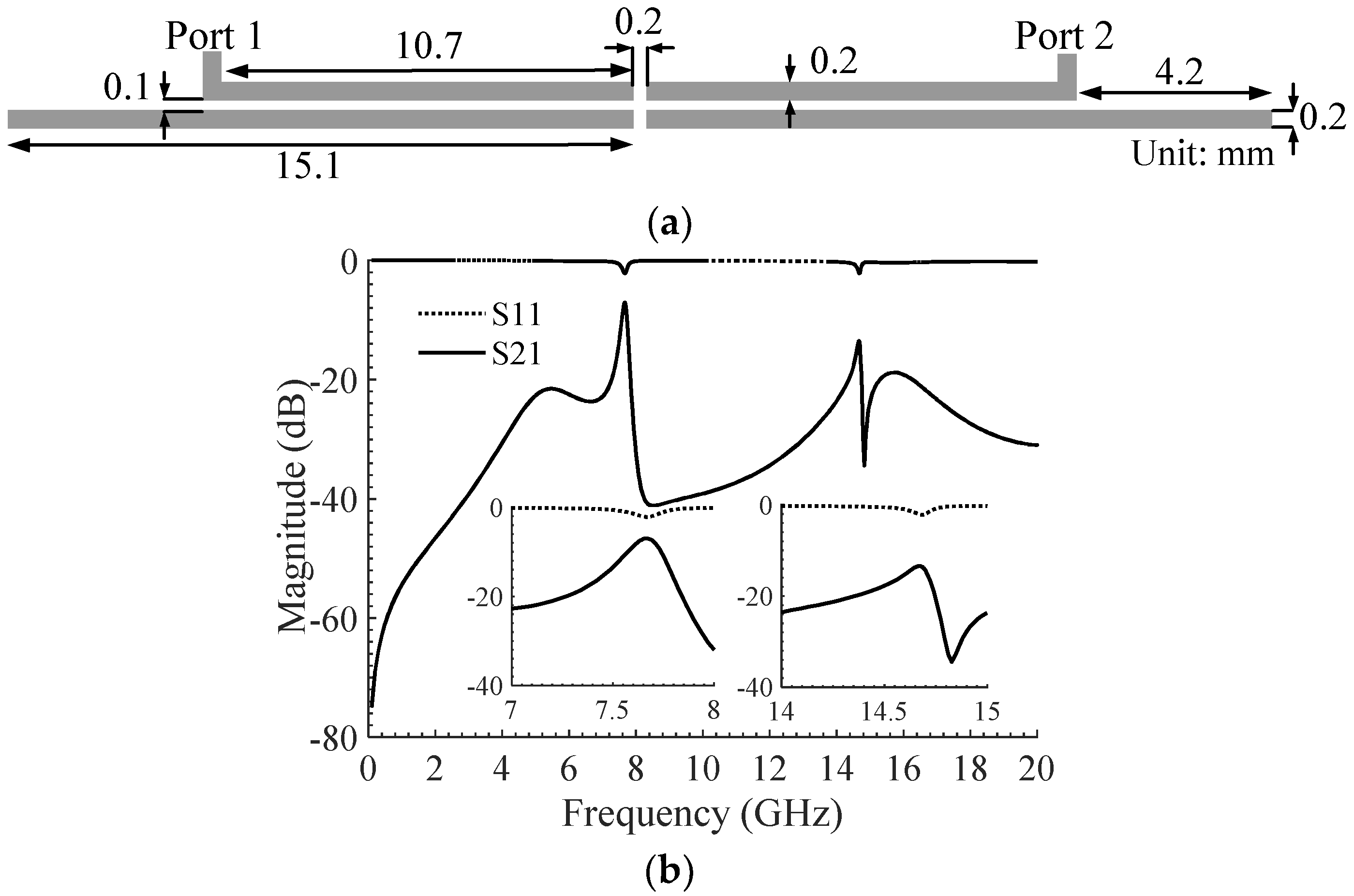

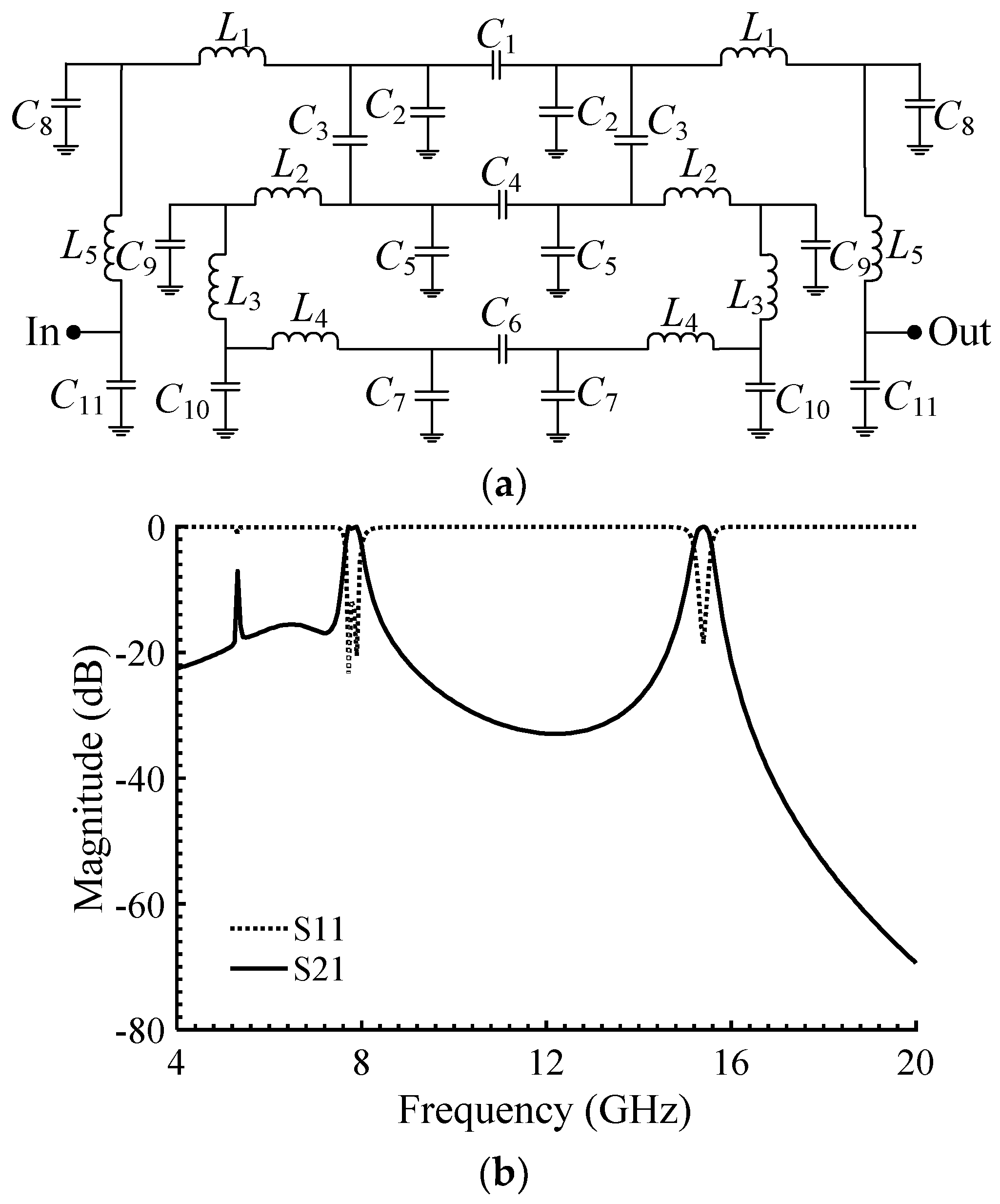
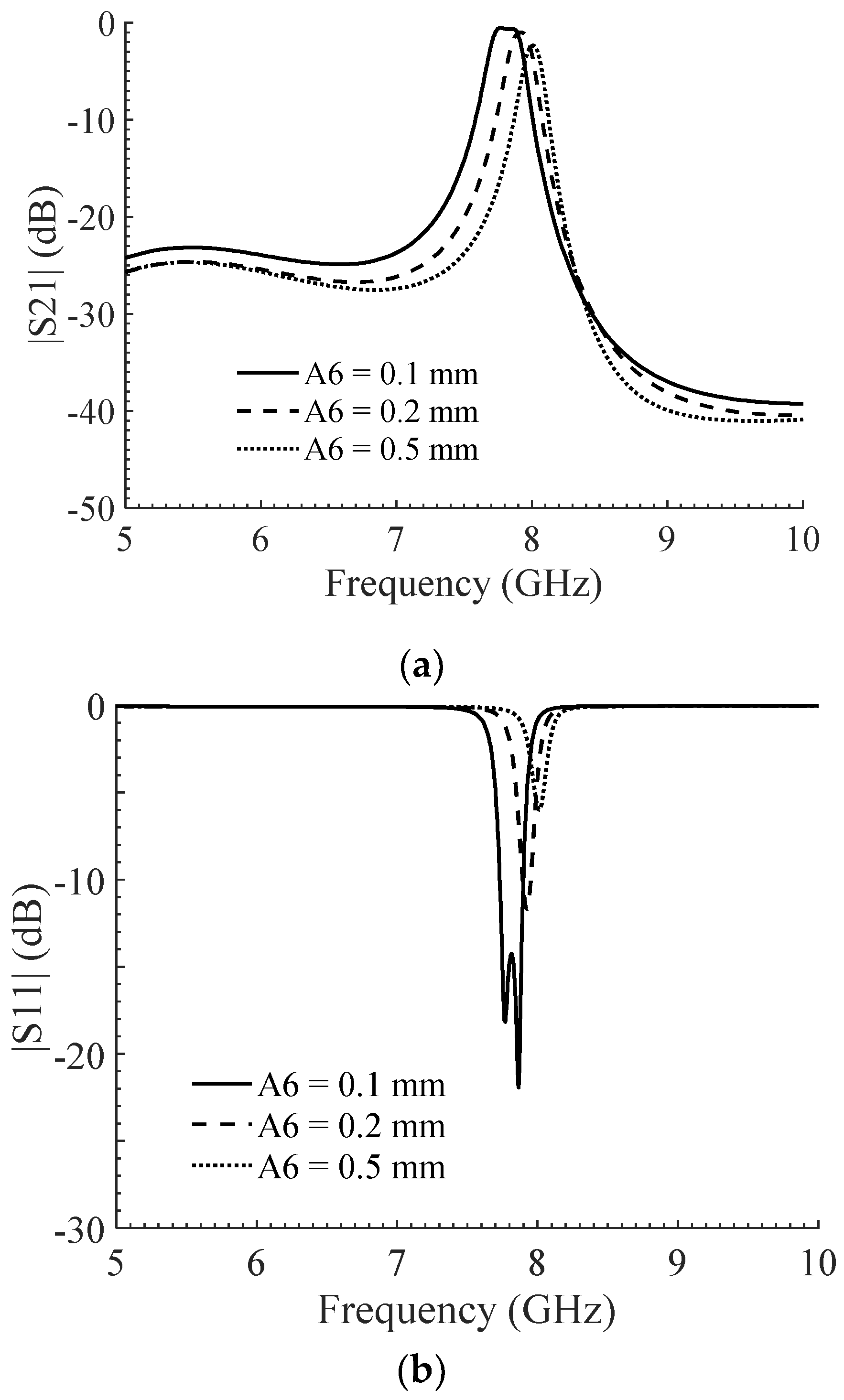
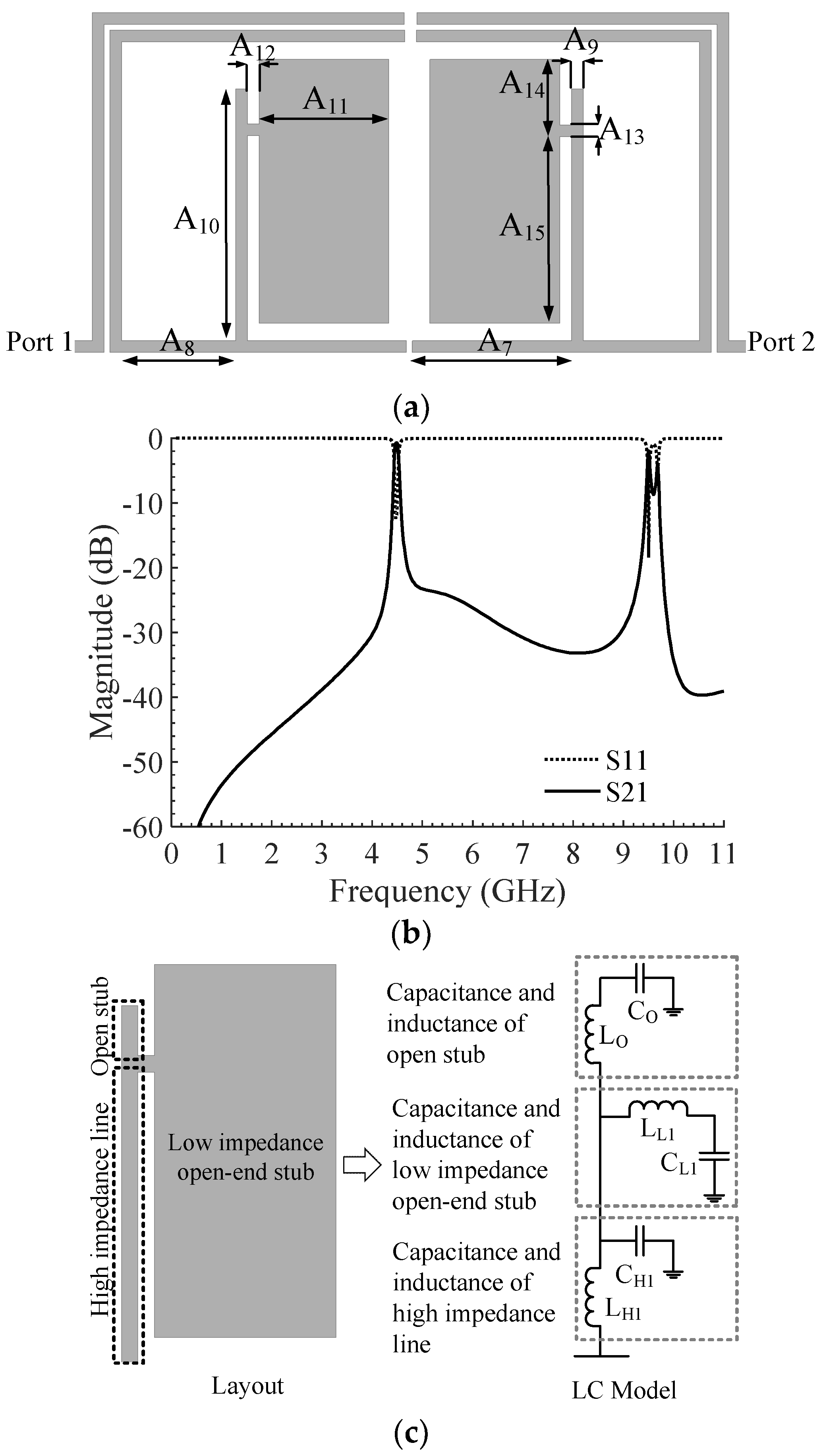


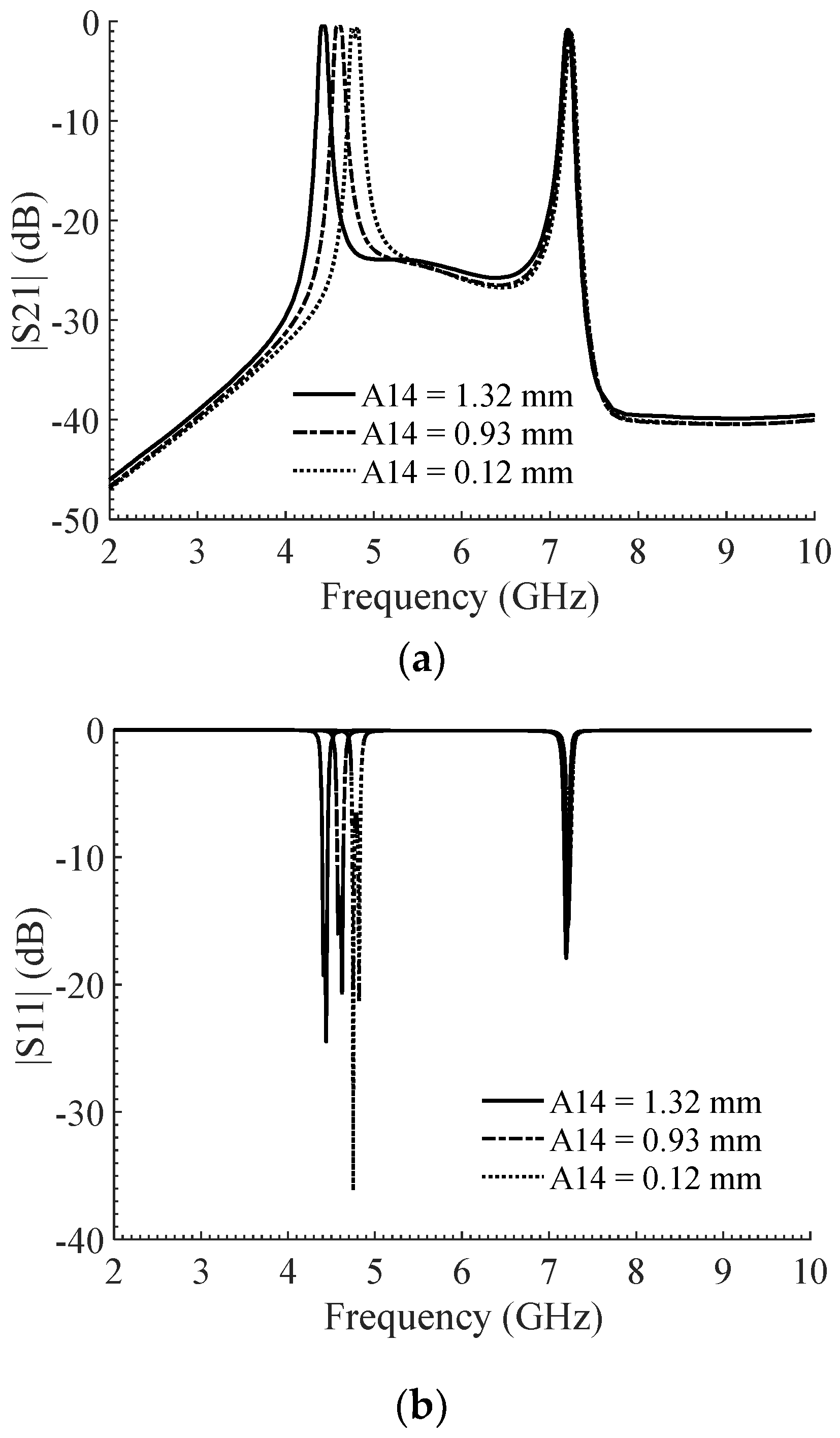
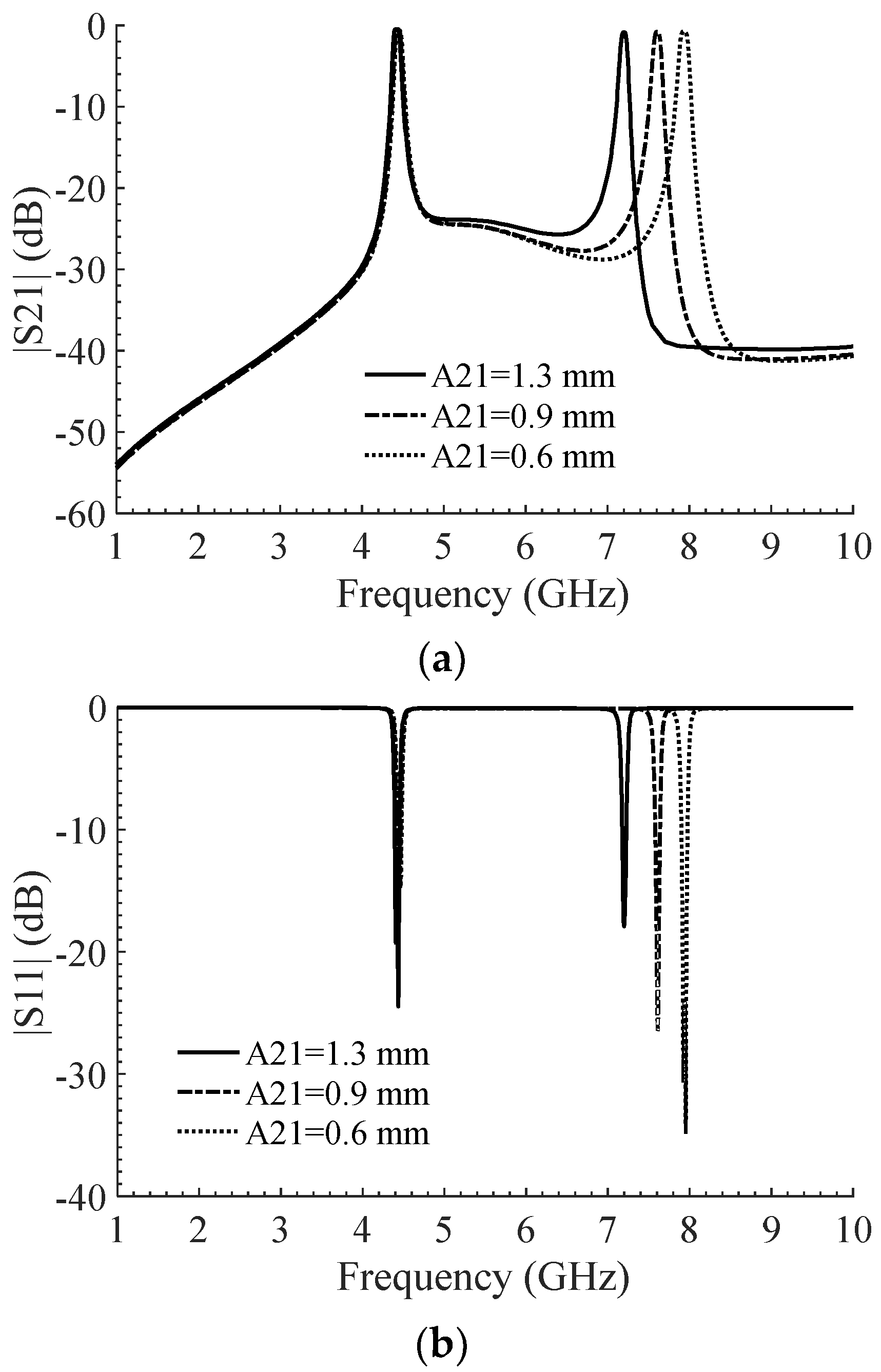

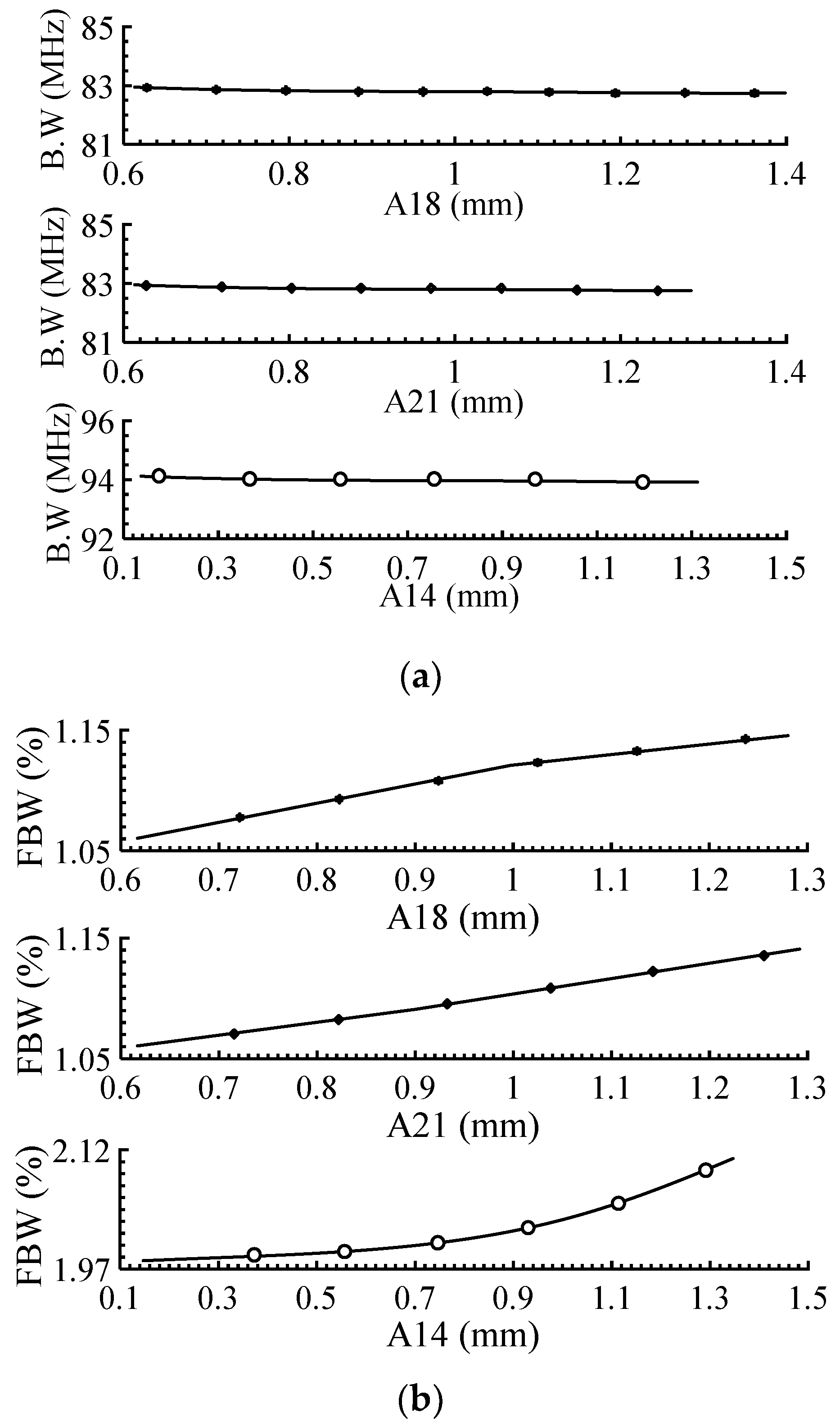
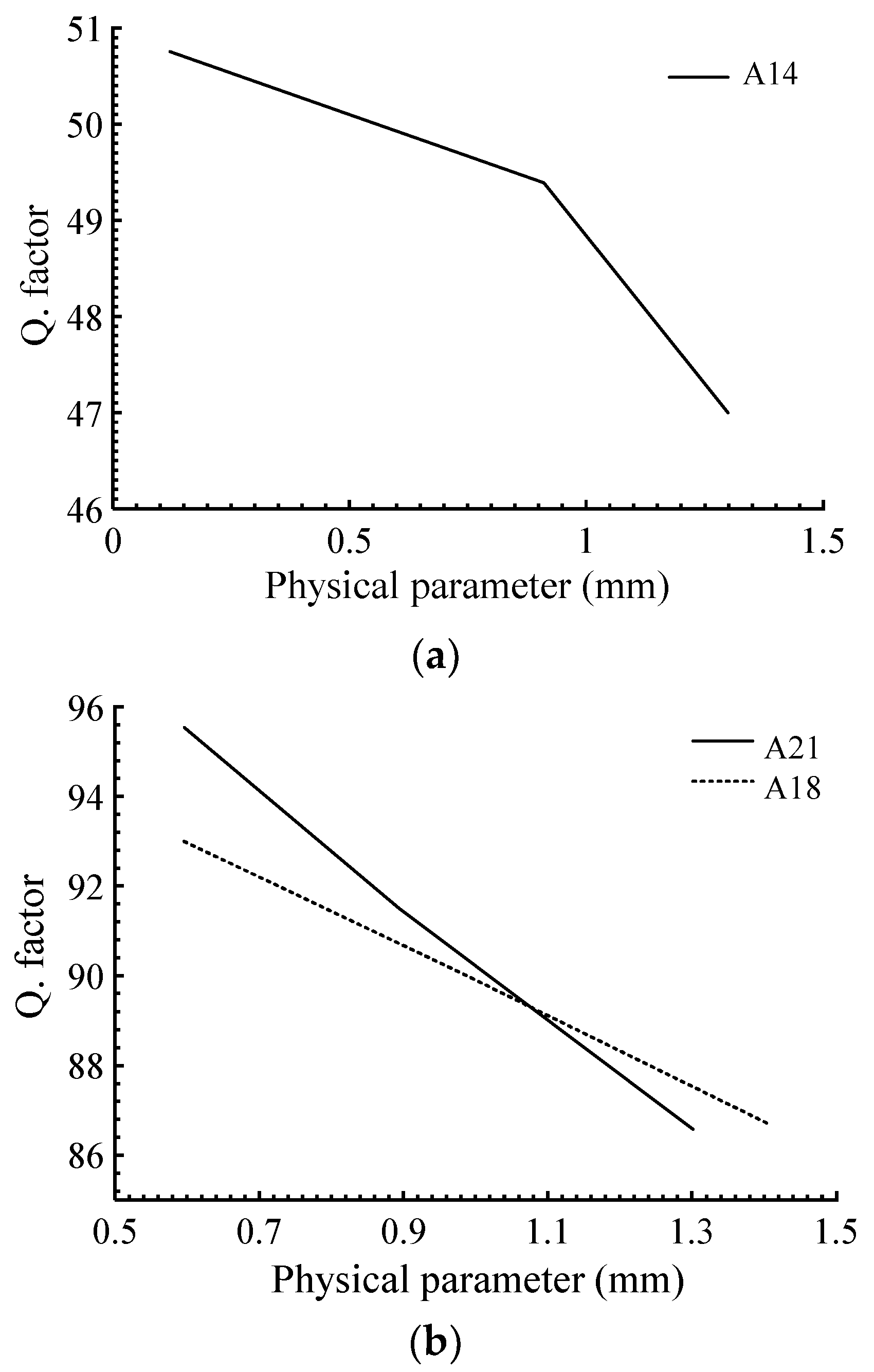
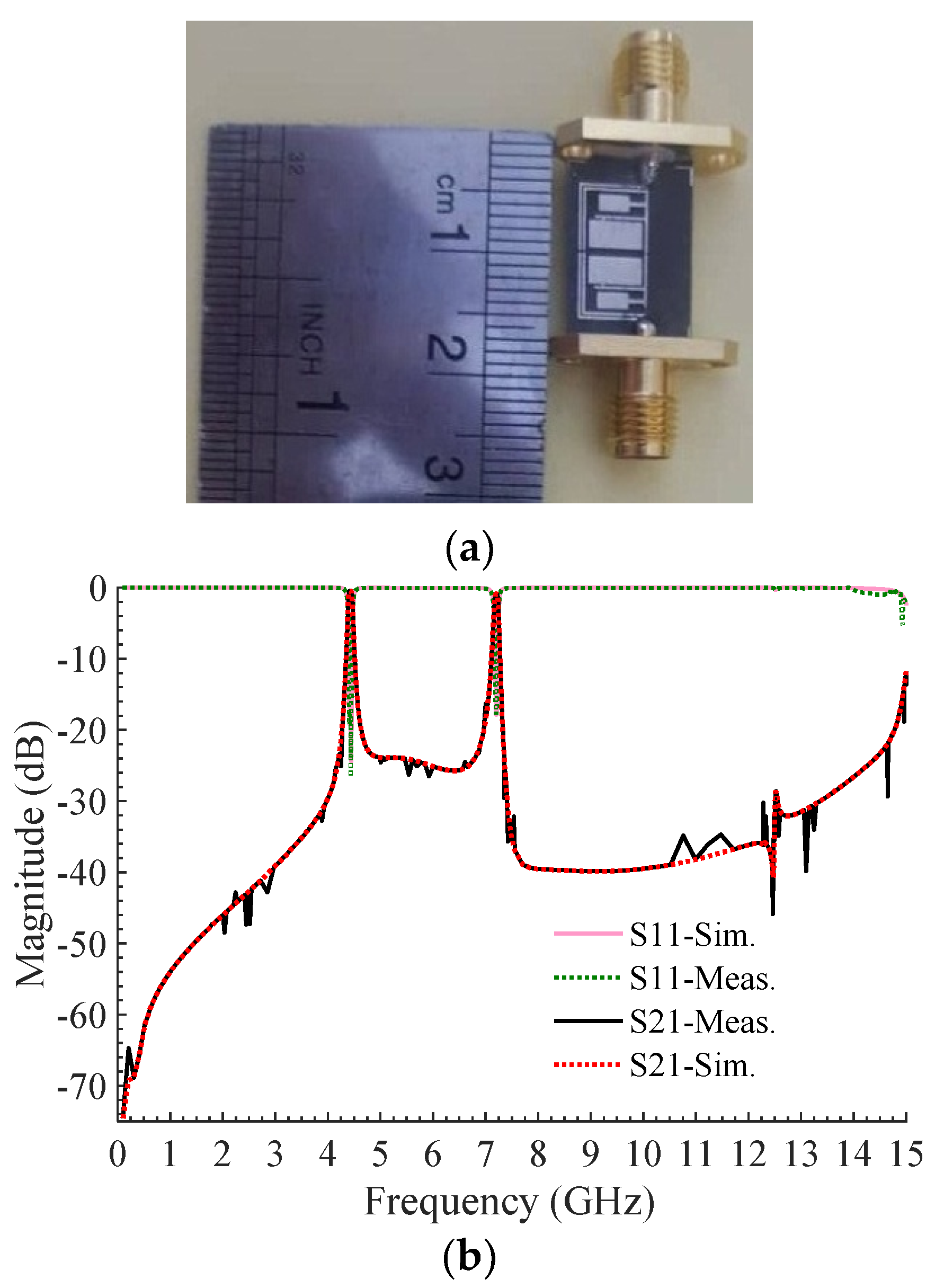
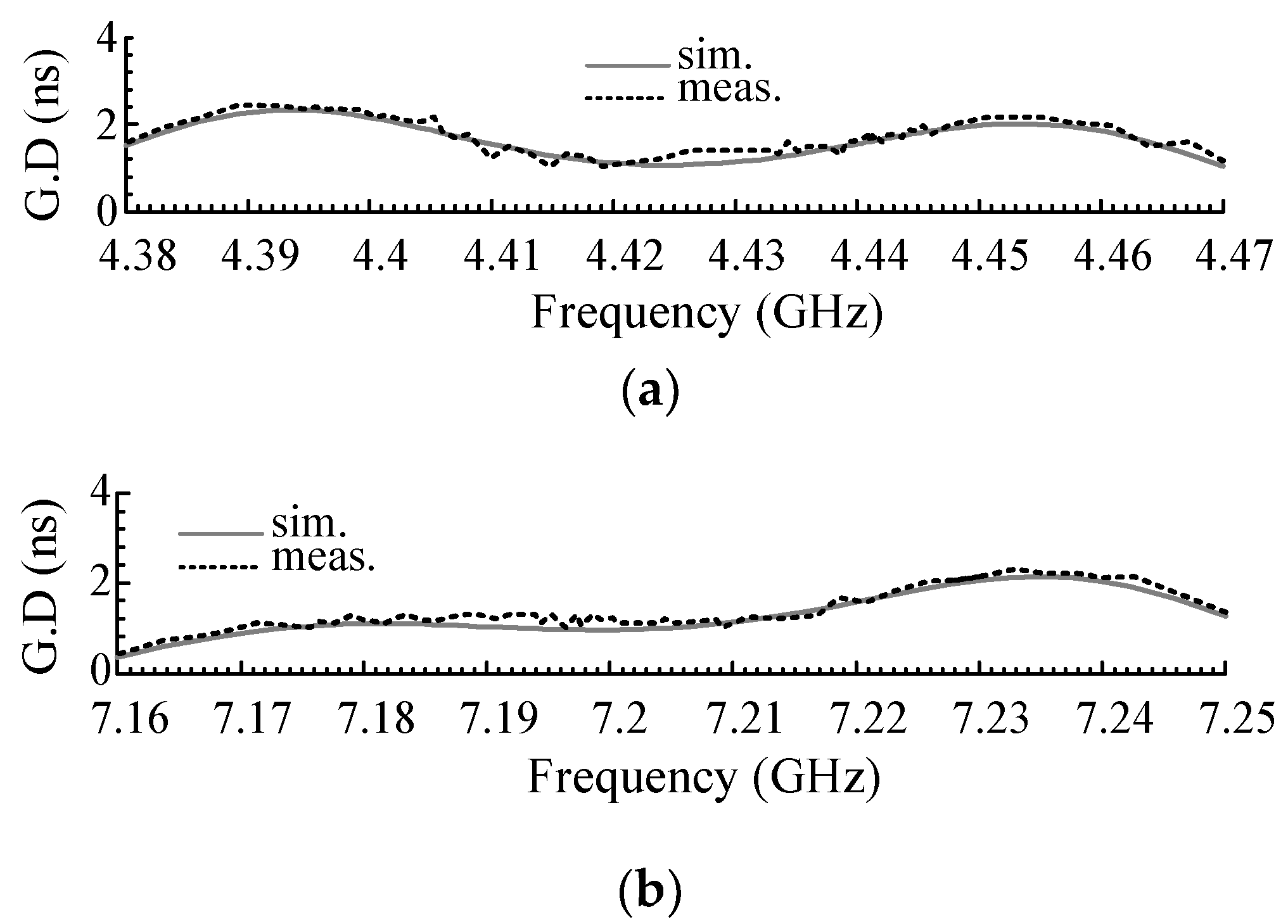
| Refs. | f1/f2 (GHz) | IL1/IL2 (dB) | RL1/RL2 (dB) | SL1/SL2 (dB) | USB | USB (GHz) | TR1/TR2 (MHz) | |
|---|---|---|---|---|---|---|---|---|
| This work | 4.42/7.2 | 0.5/0.86 | 17.56/17.9 | 30/25 | 3 f1 | 7.4–15 | 600/1000 | 0.0253 |
| [30] | 0.9/2.2 | 0.5/1 | 20/20 | 20/20 | 3 f1 | 2.4–3 | 200/200 | 0.0391 |
| [32] | 3.8/4.8 | 1.38/1.82 | 14/17 | 20/20 | 2 f1 | 5.6–8 | 500/200 | 0.0496 |
| [33] | 2.35/5.8 | 1.1/1.6 | 20/18 | 30/20 | 3 f1 | 6.5–8 | -/- | 0.0288 |
| [35] | 2.55/3.6 | 1.22/2.13 | 20/18 | 20/20 | 1 f1 | 3.7–5 | -/- | 0.1189 |
| [36] | 2.45/5.2 | 0.6/0.9 | 20/19 | 20/20 | 3 f1 | 6–7.5 | -/- | 0.0253 |
| [37] | 2.4/5.2 | 1.4/2.7 | 30/12 | 20/20 | 2 f1 | 6–11 | -/- | 0.0324 |
| [38] | 1.57/2.4 | 1.26/2.4 | 17.5/22.6 | 20/20 | 3 f1 | 2.7–5.5 | -/- | 0.0108 |
| [39] | 2.4/5.8 | 1.35/1.97 | 17/15 | 20/20 | 3 f1 | 6–9 | -/- | 0.0975 |
| [40] | 1.6/2.56 | 0.74/0.93 | 20/20 | 20/20 | 2 f1 | 2.7–4.5 | -/- | 0.005 |
| [41] | 2.5/3.5 | 1.2/1.2 | 12/12 | 20/20 | 3 f1 | 4–9 | -/- | - |
© 2020 by the authors. Licensee MDPI, Basel, Switzerland. This article is an open access article distributed under the terms and conditions of the Creative Commons Attribution (CC BY) license (http://creativecommons.org/licenses/by/4.0/).
Share and Cite
Lalbakhsh, A.; Ghaderi, A.; Mohyuddin, W.; Simorangkir, R.B.V.B.; Bayat-Makou, N.; Ahmad, M.S.; Lee, G.H.; Kim, K.W. A Compact C-Band Bandpass Filter with an Adjustable Dual-Band Suitable for Satellite Communication Systems. Electronics 2020, 9, 1088. https://doi.org/10.3390/electronics9071088
Lalbakhsh A, Ghaderi A, Mohyuddin W, Simorangkir RBVB, Bayat-Makou N, Ahmad MS, Lee GH, Kim KW. A Compact C-Band Bandpass Filter with an Adjustable Dual-Band Suitable for Satellite Communication Systems. Electronics. 2020; 9(7):1088. https://doi.org/10.3390/electronics9071088
Chicago/Turabian StyleLalbakhsh, Ali, Amirhossein Ghaderi, Wahab Mohyuddin, Roy B. V. B. Simorangkir, Nima Bayat-Makou, Muhammad Sajjad Ahmad, Gwan Hui Lee, and Kang Wook Kim. 2020. "A Compact C-Band Bandpass Filter with an Adjustable Dual-Band Suitable for Satellite Communication Systems" Electronics 9, no. 7: 1088. https://doi.org/10.3390/electronics9071088





